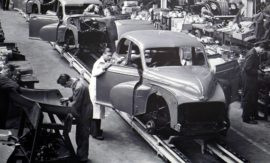Intended learning outcomes: Explain techniques for standard products with few variants as well as techniques for product families.
Course section 7.2: Subsections and their intended learning outcomes

7.2 Adaptive Techniques
Intended learning outcomes: Explain techniques for standard products with few variants as well as techniques for product families.

7.2.1 Techniques for Standard Products with Few Variants
Intended learning outcomes: Present the conventional variant structure for a few, stockable variants.

7.2.1b The Variant Master Schedule at the End Product Level
Intended learning outcomes: Explain the production plan and its corresponding MPS at the end product level.

7.2.1c The Revision of the Variant Master Schedule According to Actual Splitting as Given by the FAS, and the Variant Master Schedule at the Assembly Level
Intended learning outcomes: Describe the revision of the MPS according to actual splitting of family demand as given by the FAS. Explain the production plan and its corresponding MPS at the assembly level.

7.2.2 Techniques for Product Families
Intended learning outcomes: Present the super bill of material with option percentages x1, x2,…, xn. Describe the production plan and its corresponding MPS at the assembly level, using the example of a product family P with a number of variants in the order of the total demand quantity for the product family.
Course 7: Sections and their intended learning outcomes

Course 7 – The Concept for Product Families and One-of-a-Kind Production
Intended learning outcomes: Produce logistics characteristics of a product variety concept. Explain adaptive and generative techniques in detail. Describe the use of generative and adaptive techniques for engineer-to-order. Differentiate various ways of cooperation between R&D and Engineering in ETO Companies.

7.1 Logistics Characteristics of a Product Variety Concept
Intended learning outcomes: Differentiate between high-variety and low-variety manufacturing. Describe different variant-oriented techniques, and the final assembly schedule.

7.2 Adaptive Techniques
Intended learning outcomes: Explain techniques for standard products with few variants as well as techniques for product families.

7.3 Generative Techniques
Intended learning outcomes: Disclose the combinatorial aspect and the problem of redundant data. Present variants in bills of material and routing sheets as production rules of a knowledge-based system. Explain the use of production rules in order processing.

7.4 Generative and Adaptive Techniques for Engineer-to-Order (ETO)
Intended learning outcomes: Differentiate between the classical procedure and different archetypes of engineer-to-order. Describe the approach for basic and for repeatable engineer-to-order.

7.5 Cooperation between R&D and Engineering in ETO Companies
Intended learning outcomes: Describe different means used for cooperation between the R&D and the order-specific engineering departments. Present the portfolio of cooperation types between R&D and engineering in ETO companies.

7.6 Summary
.

7.7 Keywords
.

7.8 Scenarios and Exercises
Intended learning outcomes: Apply adaptive techniques for product families. Disclose the use of production rules in order processing. Elaborate the setting the parameters of a product family.
